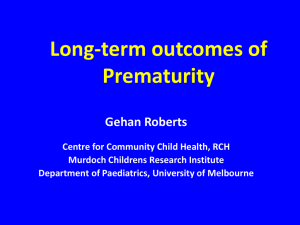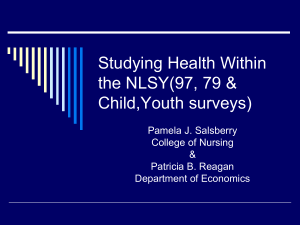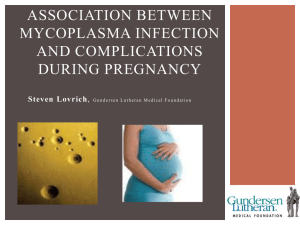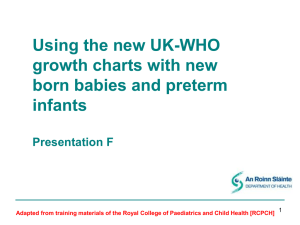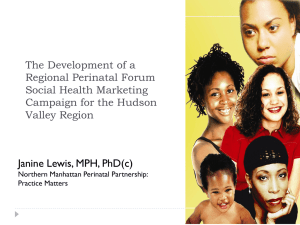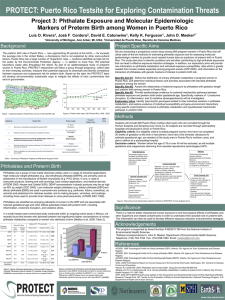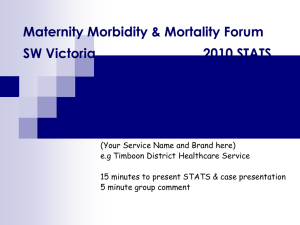Preterm Prediction and Prevention - 42nd Annual Perinatal Nursing
advertisement
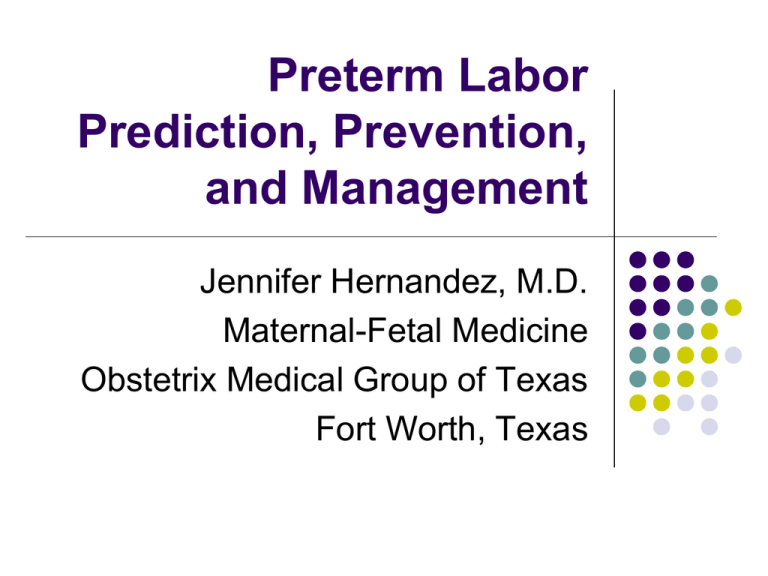
Preterm Labor Prediction, Prevention, and Management Jennifer Hernandez, M.D. Maternal-Fetal Medicine Obstetrix Medical Group of Texas Fort Worth, Texas Objectives To review the background and epidemiology of preterm birth To discuss risk factors and screening methods available for predicting women at risk and to review preventative options for those women at risk To review how to diagnose preterm labor and treatment options available for those women To discuss preterm labor in multi-fetal gestations and how these differ from singleton pregnancies Overview Preterm Birth: Background Preterm birth is defined as delivery prior to 37 completed weeks’ gestation Early preterm birth is defined as delivery prior to 34 weeks gestation Late preterm birth is defined as delivery between 34 0/7- 36 6/7 weeks’ gestation Preterm birth can be due to PTL (40-45%), PPROM (20-255%), or medically indicated deliveries (30-35%) Preterm Birth: Epidemiology The incidence of preterm birth increased more than 20% from 1990 to 2006 This was largely due to a rise in multiple gestations and medically indicated late preterm deliveries Preterm Birth: Epidemiology Fortunately, the overall rate of preterm birth in the United States is decreasing, down to 11.7 percent in 2011 This rate of preterm birth still remains higher than other industrialized countries The U.S. ranks 131st out 184 countries with reported rates of preterm birth It’s not just a disparity between countries Vermont, New Hampshire, Oregon, and Maine all have preterm birth rates < 9.6% Louisiana, Mississippi, and Alabama all have rates >14.6% Preterm Birth: Significance Why does it matter? Preterm birth is the leading cause of neonatal morbidity and mortality Long-term sequelae include neurodevelopmental deficits and increased risk of chronic disease in adulthood Preterm birth costs the health care system $26 billion annually Preterm Birth: Significance The risk of morbidity and mortality decrease as gestational age increases, but the relationship is nonlinear The point with the lowest risk is between 39 0/7 and 40 6/7 weeks Prediction Preterm Birth: Risk Factors Prior preterm birth The number one risk factor for preterm birth The more preterm births, the stronger the risk of recurrence: One prior preterm birth: 14-22% Two prior preterm births: 28-42% More than 3 prior preterm births: 67% Most recurrent preterm births occur within 2 weeks of the gestational age of the prior preterm birth Preterm Birth: Risk Factors Cervical and Uterine Factors Short cervix Cervical surgery There is an inverse relationship between cervical length by ultrasound and gestational age at delivery More to come on this later…. Ablative and excisional procedures for treatment of cervical intraepithelial neoplasia have been associate with increased risk of preterm birth Uterine malformations Congenital and acquired malformations are associated with preterm birth Preterm Birth: Risk Factors Lifestyle factors Smoking, Substance abuse Body mass index Physical activity, work, and stress Demographic factors Race African Americans are at the highest risk for preterm birth Socioeconomic status Educational status Preterm Birth: Risk Factors Infection Bacterial vaginosis and other vaginal infections Asymptomatic bacteruria Peridontal disease Multiple gestation Birth defects Threatened abortion Inter-pregnancy interval Genetic factors Preterm Birth: Screening Transvaginal cervical ultrasonography An increased risk of PTB as cervical length shortens has been observed in all populations Cervical length below the 10th percentile (25 mm) is consistently associated with an increased risk of PTB 90th percentile: 45 mm 50th percentile: 35 mm 10th percentile: 25 mm 5th percentile: 20 mm 2nd percentile: 15 mm Preterm Birth: Screening Cervical length screening by history High risk population: Prior preterm birth < 34 weeks Transvaginal ultrasound for cervical length every 2 weeks from 16 to 24 weeks Low risk population: No history of preterm birth One time transabdominal screening at anatomy ultrasound (usually ~18 weeks) with transvaginal ultrasound only if first measurement concerning Preterm Birth: Screening Fetal Fibronectin A basement membrane protein produced by the fetal membranes Thought to act as an adhesion molecule that binds the placenta and membranes to the uterine decidua Rarely found in the vagina after 20 weeks gestation in a normal pregnancy When found in the vagina after 20 weeks, it has been associated with an increased risk of spontaneous PTB Low sensitivity, high specificity ACOG no longer recommends its use as a screening tool Preterm Birth: Screening Home uterine activity monitoring Not recommended Bacterial vaginosis screening Not recommended Prevention Preterm Birth: Prevention History 17α-hydroxyprogesterone caproate injections Any woman with a singleton gestation and prior spontaneous preterm delivery should receive weekly progesterone injections from 16 to 36 weeks Use of progesterone in these high risk patients has been shown to significantly reduce the risk of recurrent preterm birth This is thought to reduce inflammation, maintain cervical integrity, and antagonize oxytocin Preterm Birth: Prevention Cervical length High risk patients Cerclage If cervical length < 25 mm prior to 24 weeks Associated with a 30% reduction in preterm birth along with decreased perinatal morbidity and mortality Low risk patients Vaginal progesterone If cervical length is < 20 mm prior to 24 weeks Associated with ~ 45% reduction in preterm birth Cerclage Has not been shown to significantly reduce preterm birth rate, even at cervical lengths < 15 mm Management Preterm Birth: Symptoms Cramping Contractions Low back pain Lower abdominal pressure Vaginal discharge Preterm Birth: Diagnosis It’s not preterm labor without cervical change Contractions alone without cervical change carry a 40-70% false-positive rate Fetal fibronectin The value is in its negative predictive value >99% for delivery within 14 days Positive predictive value Only 13-33% (!) for delivery in 7-10 days Preterm Birth: Intervention Tocolytics The goal of tocolysis is for short-term prolongation of pregnancy to allow administration of antenatal steroids a well as maternal transport if needed No evidence exists that tocolytic therapy has any direct favorable effect on neonatal outcomes Long-term use of any of these agents carries a high risk for side effects– both maternal and fetal A few examples: Magnesium sulfate, Calcium channel blockers (Nifedipine), NSAIDs (Indomethacin), Betaadrenergic receptor antagonists (Terbutaline) Preterm Birth: Intervention Antenatal corticosteroids This is the single most beneficial intervention for improved neonatal outcomes in patients who deliver preterm Neonates whose mothers receive steroids have significantly lower severity and frequency of respiratory distress syndrome, intracranial hemorrhage, necrotizing enterocolitis, and death (compared to those who do not receive steroids) Betamethasone and Dexamethasone are the most widely studied corticosteroids and are equivalent in efficacy Preterm Birth: Intervention Antenatal corticosteroids A single course of steroids is recommended for any woman at risk for preterm delivery between 24 and 34 weeks A single rescue course at least 2 weeks after the first course has additional neonatal benefit However, regularly scheduled repeat courses are not recommended Preterm Birth: Intervention Antibiotics It has been theorized that infection or inflammation are associated with contractions However, it has never been shown that antibiotic treatment in women with preterm labor and intact membranes have any benefit in prolonging the pregnancy This is different than the important antibiotic prophylaxis for GBS prophylaxis and in the setting of rupture of membranes Preterm Birth: Intervention Neuroprotection Pre-delivery administration of magnesium sulfate reduces the occurrence of cerebral palsy Magnesium sulfate should be given with the intent for neuroprotection when birth is anticipated prior to 32 weeks Same protocol essentially as magnesium for tocolysis and preeclampsia seizure prophylaxis Multiples Preterm Birth: Multiples In 2006, 60% of twins and 93% of triplets were born preterm Unfortunately, many of the strategies listed previously are ineffective or actually detrimental in a multi-fetal pregnancy Progesterone treatment does not reduce the incidence of preterm birth Cerclage may actually increase the risk of preterm birth– not recommended Tocolytics carry a much higher risk of side effects in this population Preterm Birth: Multiples There is not even adequate data to demonstrate benefit from the use of antenatal steroids in multiple gestations However, because of the clear benefit attributable to corticosteroids in singleton gestations, steroids are readily utilized in multiple gestations The same concept applies to magnesium sulfate for neuroprotection Conclusions Preterm Birth: Conclusions Preterm birth remains a common complication for many women in the United States It carries a huge financial burden for families affected as well as the health care system as a whole There are multiple risk factors for preterm birth, but a prior history of this event is the strongest predictor of recurrence Preterm Birth: Conclusions There are few reliable methods of prediction available– maternal history and cervical length There are even fewer reliable methods of prevention once an increased risk of preterm delivery is identified– progesterone and cerclage Preterm labor can be elusive at times Preterm Birth: Conclusions Once preterm labor is diagnosed, several treatments are available to reduce the neonatal morbidity and mortality if preterm birth occurs– antenatal steroids and magnesium sulfate Multifetal gestations have a very high risk of preterm birth, but unfortunately, effective prevention and management options are limited in this setting Questions? Thank you! References Prediction and prevention of preterm birth. ACOG Practice Bulletin Number 130, October 2012. Cunningham FG, Leveno KJ, Bloom SL, et al. Williams Obstetrics. 23 rd edition. McGraw Hill. 2010. Goldenberg RL, Mercer BM, Meis PJ., et al. The preterm prevention study: fetal fibronectin testing and spontaneous preterm birth. Obstet Gynecol. 1996;87:643-48. Goldenberg RL, Iams JD, Das A., et al. The preterm prevention study: sequential cervical length and fetal fibronectin testing for the prediction of spontaneous preterm birth. Am J Obstet Gynecol 2000;182:636-43. Iams JD, Geldenberg RL, Meis PJ, et al. The length of the cervix and the risk of spontaneous premature delivery. NEJM 1996;334:567-72. Lockwood CJ, Senyei AE, Dische MR, et al. Fetal fibronectin in cervical and vaginal secretions as a predictor of preterm delivery. NEJM 1991;325:669-74. To MS, Alfirevic Z, Heath VC, et al. Cervical cerclage for prevention of preterm delivery in women with short cervix: a randomised controlled trial. Lancet 2004;363:1849-53. Goya M, Pratcorona L, Merced c, et al. Cervical pessary in pregnant women with a short cervix (PECEP): an open label randomised controlled trial. Lancet 2012;379:1800-6. Rouse DJ, Caritis SN, Peaceman aM, et al. A trial of 17 alpha-hydroxyprogesterone caproate to prevent prematurity in twins. NEJM 2007:357:454-61.
